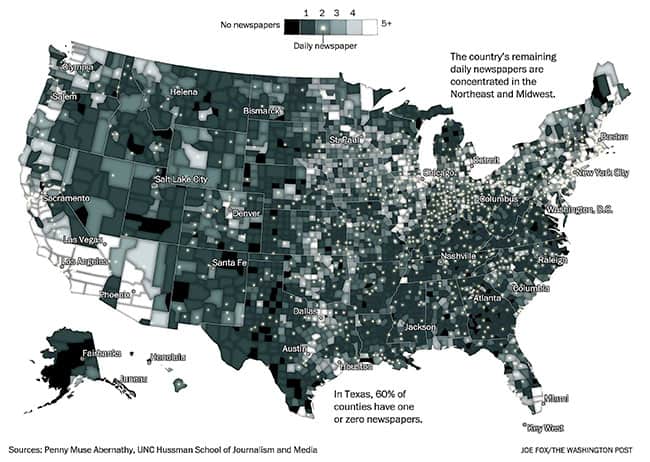More surprises in the world of publishing

by Peter Weinberger | pweinberger@claremont-courier.com
Over the past several months, the COURIER has published a number of stories talking about the demise of local news throughout the U.S. We focused on what many of us call “news deserts,” where cities have little to no access to local news. But even with the large numbers of newspapers going out of business, it’s still been difficult to visualize how this all looks — until now.
This week the Washington Post published a map (above) that shows how little access the public has to local news. The darker the color, the less local news. It’s important to note that this news is basically bad, except for spots on the east and west coasts. Now, the chart shows only newspaper businesses, so obviously the internet has picked up some of the slack, especially this year when there is more support for local news start-ups. Unfortunately, the history of meaningful online local news coverage has not proven to replace newspapers. So far, they have been unable to support the professionals needed to report and edit. But this could change when others follow nonprofit models similar to the one used by the COURIER.
Given all the misinformation that is so prevalent now, any voice with accurate and objective reporting can only help. I believe 2022 will be a year of substantial change in local media … and it won’t be all bad news.
Printers going out of business
The price and access of newsprint to print newspapers has always been influenced by a number of economic factors. And 2021 is no exception, as newspaper printers are going out of business at an alarming rate. Just in Southern California alone, six printers have shut their doors this year. With the country’s shipping connections hampered, newspaper printers tell us there are shortages everywhere, especially for higher quality newsprint.
Another issue has taken people in the printing business by surprise. They simply cannot find enough workers to operate the large presses that roll most days and nights. If the presses are not rolling, printers lose money because of the high cost of press maintenance. Plus, the pandemic has caused many workers to rethink their jobs, causing mass resignations.
These issues will cause the longtime COURIER printer, Southern California News Group (SCNG), to close their doors by the end of this year. I’ve been looking for a replacement for two months and should arrive on a decision next week. But it has been difficult given that only a few printers are accepting new business. And there’s no question it will come at a 25 to 40 percent increase in price.
There are many moving parts and people needed to produce and print the COURIER each week. From reporters writing stories, to editing, proofing, taking photos, paginating the design of each page, printing using huge rolls of paper, then counted, folded and sent back to us. At the COURIER, our mailing crew sticks mailing labels on every issue, bags the papers, then off to the post office where we rely on a USPS mail carrier to take the final step to deliver your paper.
Don’t get me wrong, this process still works. But like many other industries, it’s ever changing …and always challenging.







0 Comments